If you’ve recently welcomed a new little furry bundle into your home, congratulations! Years of pure love, sloppy kisses and wonderful memories are coming your way.
But as adorable as puppies undoubtedly are, unfortunately, they don’t come pre-programmed NOT to poop on your favorite rug, or leave an unwelcome puddle in the hall.
These small bundles of energy and canine curiosity are full of fun. But for many new pup parents, house training can seem a daunting, at times almost unachievable task!
If you’ve found yet another stinky gift in your house, don’t lose hope. In this in-depth guide, we discuss all you need to know to make potty training your puppy easier and faster!
When to Start House Training Your Puppy
The best time to start house training is once your puppy is between 12-16 weeks old.
At this age, your puppy will have enough bladder and bowel movement control to be able to learn to hold it in, making it possible for you to get your pup to their potty spot BEFORE they let it all go.
If you are looking to house train a younger puppy, you should bear in mind that they will only begin to develop an awareness of when their bladder is full at around eight weeks old.
Puppy potty training can, in theory, be started from eight weeks. However, house training at this age is more about getting into a regular routine.
At such an early stage, you can’t realistically expect your pup to be able to hold himself in. Any younger than eight weeks and your puppy will lack any bladder control ability at all.
To sum up, you can start potty training your pup from eight weeks; however, the best age to house train your puppy is between 12-16 weeks when your pet will have better control of his bladder and a better comprehension of the training process.
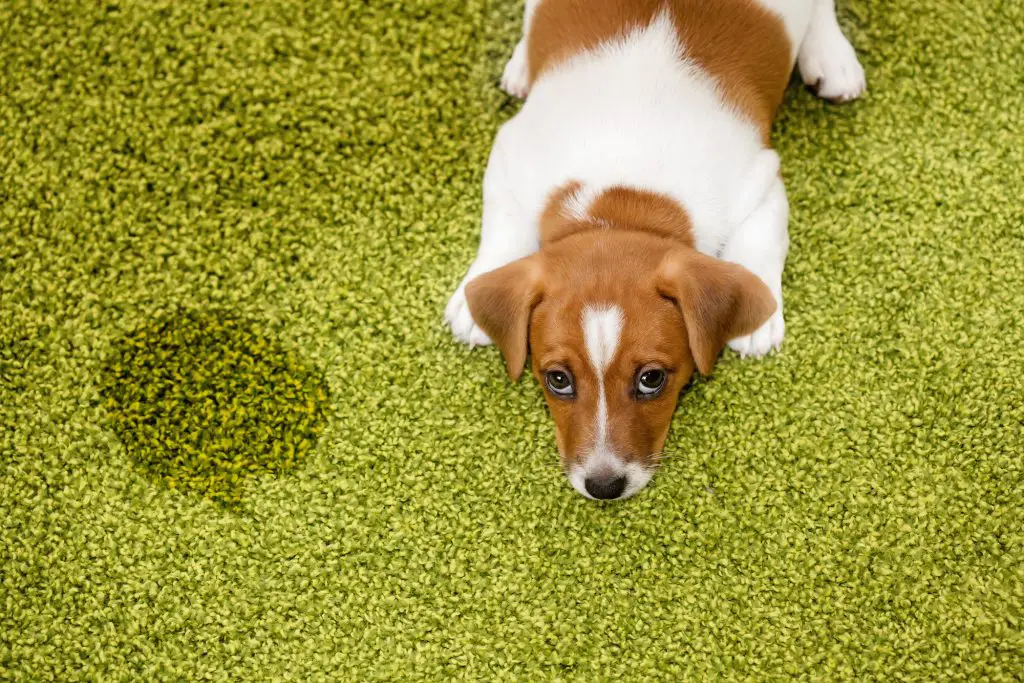
How Long Does it Take to Potty train?
It all depends.
In general, to get your puppy fully potty trained from scratch, you should allow between four to six months. Of course, this can be achieved much faster; however, this will depend on you putting in extra hours supervising your puppy and really devoting yourself to the training process.
In general, the younger the puppy, the longer you should expect it to take. While older dogs can be trained in as little as several days, younger, smaller dogs have smaller bladders – smaller bladders get fuller quicker and need emptying more frequently!
Also, bear in mind that if your puppy is over 12 weeks and has been used to doing his business in a cage, it can take quite a while longer to establish a good puppy potty training routine.
If you have the time to take your puppy out for potty breaks several times throughout the day, every day, and a consistent approach to puppy potty training, then you could succeed in a matter of weeks. Although even if your puppy has gone weeks without an accident, like toddlers, they can still have their off days.
While complete house training may take somewhat longer, you should be able to get your pup aware of where they should relieve themselves within weeks rather than months.
Can you Potty Train an Older Dog?
The saying you can’t teach an old dog new tricks is pretty much unfounded. In fact, older dogs are often much easier to potty train than puppies.
With a lot of understanding, encouragement, and good communication, they generally learn to do their business where they should after a week or two or even just several days.
For one thing, older dogs already have fully developed bladders and are physically capable of going longer between toilet breaks than small pups. However, you will need to take your adult dog’s previous lifestyle into account and try to understand why they have toilet accidents and how you can train your older dog to do their business outside.
As with puppies, it is essential to stick to a routine and to be extremely vigilant, especially during the first few days.
While older dogs are capable of going for much longer between potty stops than younger ones, you still need to factor in any behavioral issues and put in as much time as you would with a new pup to get the best results.
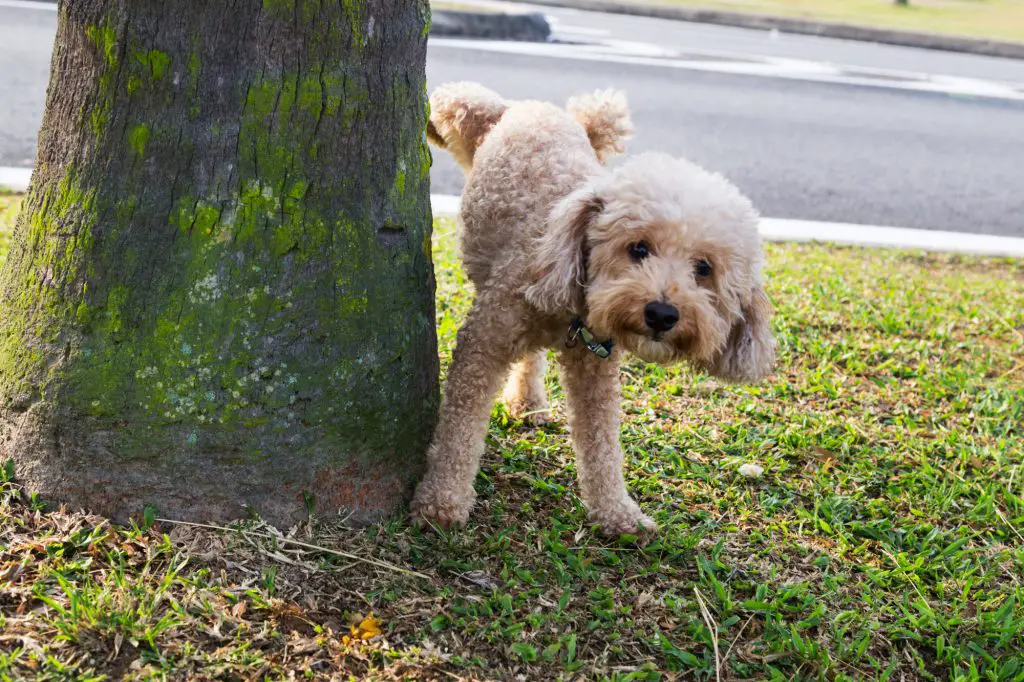
How to Know When Your Dog Needs to go
There are several signs that you should keep an eye out for that will let you know when your dog needs a potty break.
When your puppy is roaming free in your home, you’ll need to keep a close eye on what they are up to. If your puppy displays one or several of the following behaviors, you should take him or her out immediately to the established potty spot.
- Sniffing around.
- Pacing.
- Sniffing the floor.
- Barking at the door.
- Pacing.
- Circling.
- Squatting.
While squatting may leave you too little time to completely avoid an accident, you may still be able to get your puppy outside to finish off their business.
In most cases, provided you are able to play close attention to your pup and their behavior, you should easily be able to pick up on the signs. This is essential to getting your puppy to where he needs to be in time and preventing any house training accidents.
How to Potty Train
Wondering how to potty train your puppy for best results? Here are our guidelines for successfully potty training your dog.
Create Routines / Rituals with your Dog
The most important part of potty training your dog is creating a consistent routine that is adapted to your puppy’s age and lifestyle.
First off, you will need to establish a feeding schedule. This will allow you to plan your puppy’s toilet breaks around eating times for better chances of success.
Once you have decided on your feeding schedule, it’s important to stick to the same times every day. Then you will need to establish a routine for taking your puppy out.
Here are our top tips to get your puppy to do his business outside.
- Take young pups out for frequent trips every 20-30 minutes when not sleeping. This will increase the likelihood of you being outside when they need to go, giving you the opportunity to praise them and reinforce good behavior.
- Always take your puppy out:
- First thing in the morning.
- Just before bed.
- After every meal.
- After playing, drinking water or napping.
- Regularly throughout the day.
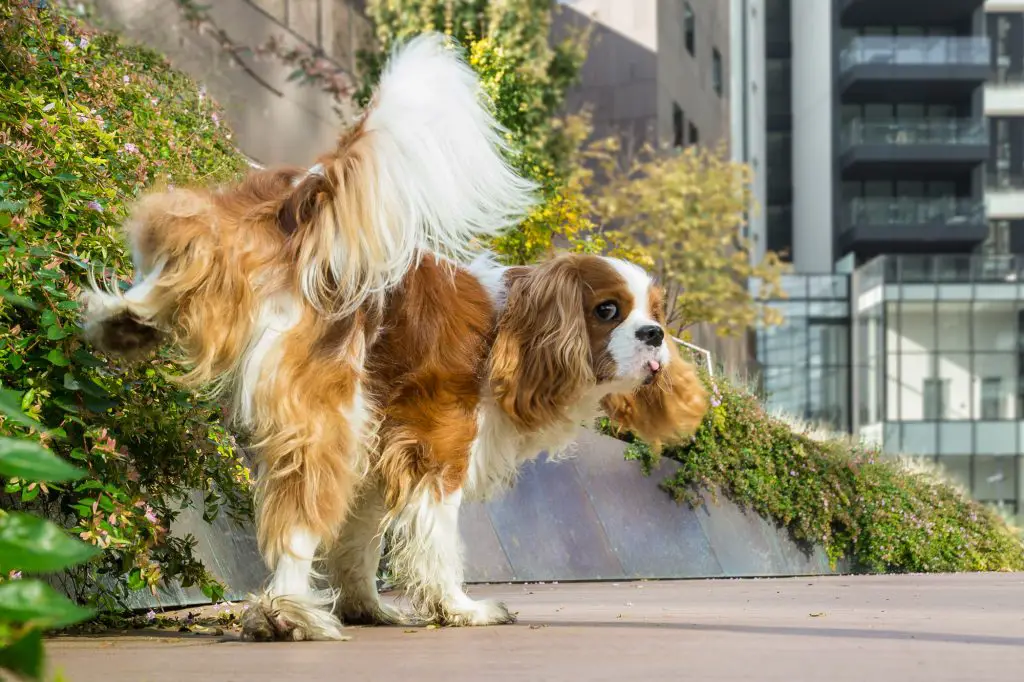
Choose a potty spot
Pick a place where you want your puppy to go. It should be easily accessible and you should always take the same door out to the spot.
Once your puppy has used this spot a few times, he will become accustomed to using it as his toilet. You’ll need to find somewhere that is not visited by other dogs, at least up until your pup has had his third set of vaccines.
Once you have found an appropriate place, take your puppy there at regular intervals as suggested above. It’s best to ignore your puppy when you’re at the potty spot so he or she doesn’t become distracted. Plus, you want to save your enthusiasm and praise for immediately after the event.
Give your dog enough time to do their business, but don’t wait around too long. If your pup goes, reward them with plenty of praise and a treat, followed by a short walk or playtime. If your puppy doesn’t go, then take them back inside and try again in another 15 minutes or so, being sure to keep a close eye out for any of the tell-tale signs.
Some dog trainers recommend using a “cue word” to encourage your dog to go to the toilet. The idea is that once your puppy is older and either travels or you change routine, you will only have to say that specific word and they will know it’s okay to relieve themselves in that place.
Once your dog has been, say your chosen word out loud and do so every time, before praising your pet. This will also help to reinforce their association of the potty spot with the action of peeing and pooping.
Teach your dog to alert you when they need to go to the bathroom
With a little effort and practice, you can easily tell when your dog needs to go to the bathroom.
To make these hints even clearer, you can teach your dog to let you know when it’s that time, here’s how. Note that your dog should already be house trained before adding a new behavior to learn.
- Leash – Teach your dog to bring you his leash when he needs to go outside. Start off by encouraging your dog to briefly hold his leash in his mouth before praising him, attaching it and taking him out. Gradually encourage your dog to take hold of his leash and build up to the point where he picks it up of his own accord and brings it to you.
- Bell – Hang a bell on your door handle and show it to your dog. Each time you take him out, encourage him to ring the bell. Some dogs prefer to use their nose, others their paws. Use lots of praise and encouragement. Eventually your dog will associate going out with ringing the bell and will ring it when he needs to go.
- Bark – Train your dog to bark on command by getting him excited enough to bark, then reward. Repeat over several weeks until your dog will bark when requested. Then, go to the door and ask him to bark. Reward him by opening the door and praising. Repeat and your dog will soon understand to bark at the door when he wants to go out!
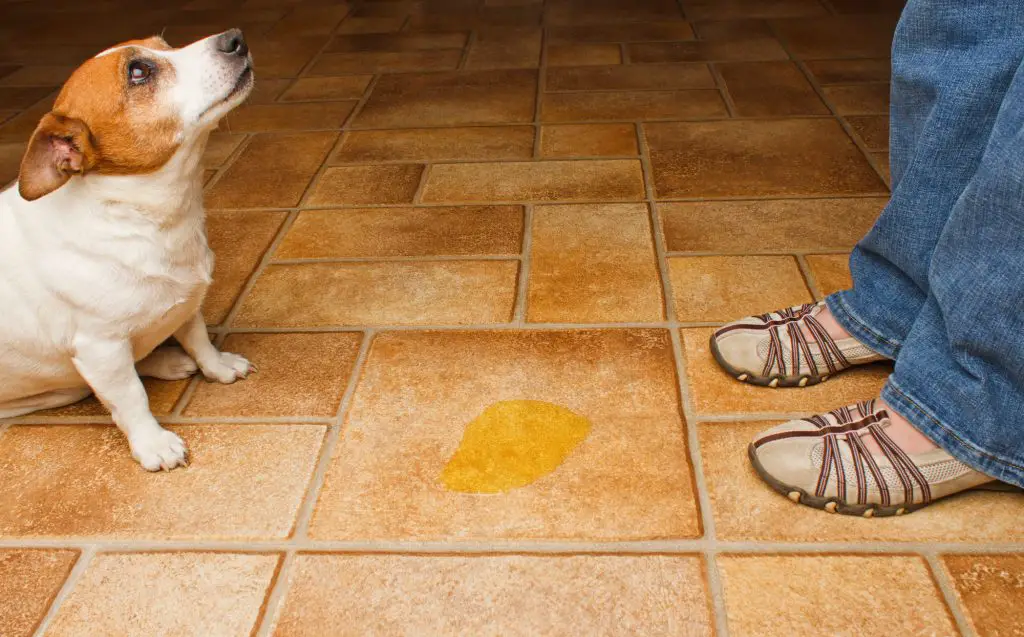
Indoor Training vs. Outdoor training
Indoor training can be confusing if the desired end result is that your dog relieves him or herself outdoors.
However, during the early stages of puppy house training, if you cannot take your dog outdoors as frequently as a young pup needs, or if you live in an apartment block, you may find that your puppy can benefit from some indoor potty training.
Puppy pads can be an excellent way to allow your puppy to relieve themselves when you’re in one of the aforementioned situations. They are generally successful as they are impregnated with a scent that encourages your pup to use them. Make sure that you place your puppy pads near to your door so that your puppy will get a head start on progressing to going outside.
Be sure to limit your untrained pup’s space indoors. If your puppy is free to roam around your home then you won’t be able to catch him when he’s about to go. Baby gates can be useful, keeping your puppy in sight where you can be ready to take him out as soon as required. Also, be sure to choose an area that is easy to clean. Accidents will inevitably happen and it’s important that you can clean up any soiling thoroughly to eliminate the scent and avoid any repeat behavior from occurring.
Encourage your dog to go out frequently to reduce the chances of any mishaps from occurring. You can also keep your puppy on a short leash, this will alert you to any sudden changes in their behavior without you having to study them as closely.
However, you will still need to make sure that your dog has adequate playtime and a chance to relax and express himself.
When to Use a Crate
When you can’t keep a close eye on what your non-potty trained pup is up to, crate training can be indispensable and really help to speed up the training process. Most dogs that are crate trained will voluntarily enter their crate to rest, seeing it as a peaceful, safe haven.
Choose a crate that is just large enough for your dog to turn around in, as well as being able to lie down and stand up. The idea is, not only will your puppy feel safe and secure in his crate, he will also be reluctant to soil his sleeping area. This is why it is important to adapt your crate size to your puppy. Too large and he’ll risk using a spare corner as a toilet and the rest for sleeping (source).
As your puppy won’t want to soil his bed, he’ll learn to hold on, which is an invaluable part of the learning process. However, be sure to limit the amount of time your pup spends in his crate so it remains a welcome place to rest where he feels safe and not a prison.
As a rule of thumb, your puppy’s age in months plus one is a ballpark figure of how long he should be able to hold it in for. It’s generally recommended that you don’t crate your pup for more than four hours at a time throughout the day.
Preparing for Night
It’s important to stick to a routine when house training your puppy.
Before bedtime, you will want to make sure that your new puppy has had ample opportunity to relieve him or herself before settling down for the night.
Here’s our tips on how to prepare your puppy for an accident-free night.
- Routine – Get into a daily routine and stick to it. This will allow your new puppy to physically and mentally adapt to their new lifestyle
- Calm time – As bedtime approaches, you don’t want your puppy to be running around like crazy. Excitement often leads to accidents and while you want a tired pup that will sleep soundly, too much excitement at the very end of the evening is not a good thing.
- Limit food/water access – Restrict access to food and water for an hour or two prior to bedtime. This will help to prevent any overnight accidents and is another reason why we recommend avoiding thirst-inducing exercise right before bed.
- Pre-bedtime toilet trips – Take your puppy out at least once just before bedtime. If possible, also take him an hour or two earlier with a quick stop just before you tuck him in for the night.
- Provide ample opportunity to go – If you can’t manage two evening toilet stops, then take your time and walk him around the block and come back to his potty place in order to give him plenty of chances to completely empty his bladder. Otherwise, make sure you spend long enough at his potty place so he has ample opportunity to go. If you don’t, you’ll likely find you have to go back out a few minutes later.
Tips When Leaving Them Home
Remember, young puppies need frequent toilet breaks regardless of your schedule.
If you need to leave your puppy unattended at home, be sure to take him or her out before you leave and on your return to avoid any accidents in your absence.
If possible crate your puppy so he won’t pee while you’re gone and will feel safe and secure. If you are going to be away for several hours you should ask a friend or dog walker to call in to take your puppy out. Make sure that you have briefed them on your puppy potty training routine and potty place so that your dog doesn’t get confused.
Once your puppy gets older, you will be able to leave him for longer periods. However, to ensure that house training goes well, it is essential that you, or someone helping you, is available to let out your puppy at least once every four hours.
Rewarding your Dog with Praise
Once again, consistency is key.
Always reward your puppy with a cheerful, happy tone when he or she goes in the right place. This is known as ‘positive reinforcement’ and it’s really important.
When your puppy is young, the bigger a fuss you make of your dog to celebrate correct toilet behavior, the sooner the penny will drop. Your dog wants to make you happy and once he understands what you want, then puppy potty training becomes much easier.
Some owners like to give their dog a treat as an added incentive to do their business where they should. Be sure to take treats out every time and reward your puppy immediately to ensure he makes the connection between relieving himself outside and receiving a treat.
Aside from treats, you could also reward your pup by playing with their favorite toy as soon as they have gone in the correct place. In any case, however you choose to reward your dog, it’s advisable not to return back inside immediately. Doing so regularly could encourage your puppy to hang on if he is always taken back inside as soon as he goes. (source)
Dealing with Accidents
Accidents will happen. The most important thing is not to get angry or to yell at your puppy. Absolutely do not do this. Ever.
If you scare him, chances are, he’ll be too frightened to relieve himself in your presence both indoors and outdoors. This can lead to your puppy secretly peeing in hard to reach areas that are equally hard to clean, resulting in a much longer training period.
Certain plush textures and soft furnishings can be extra attractive to dogs, so you may want to remove any rugs or floor cushions for the first few weeks of training to make cleanup easier. Even so, your puppy is still going to go indoors, until they learn that that is not what is required.
Be sure to dissuade your puppy rather than scaring him or her. If you catch your pup in the act, or preferably about to go, use a firm, brisk “No!” or clap your hands to attract their attraction and to make them aware that you are unhappy with what they are doing or about to do. Remove your puppy immediately to their potty place and reward them with a cheerful, happy voice if they finish their business there.
There will be some accidents that you won’t catch on time. If you spot one after the event, don’t ever be tempted to tell your dog off for it. Afterwards it is too late and you’ll only risk confusing or scaring your pup. The best thing to do, is to be sure that you adequately clean the area. Otherwise, your dog may recognize their odor and be tempted to reuse the same site again and again.
Enzymatic cleaners are a good way to remove all of the sensory evidence of past mishaps. That way your dog will associate only their designated potty place with doing their business and not your living room floor.
It is important to note that if your dog has frequent mishaps with no signs of improvement, it could be the result of medical issues. In this case, it’s best to get them checked out by a vet in case of illness or a urinary tract infection (source).
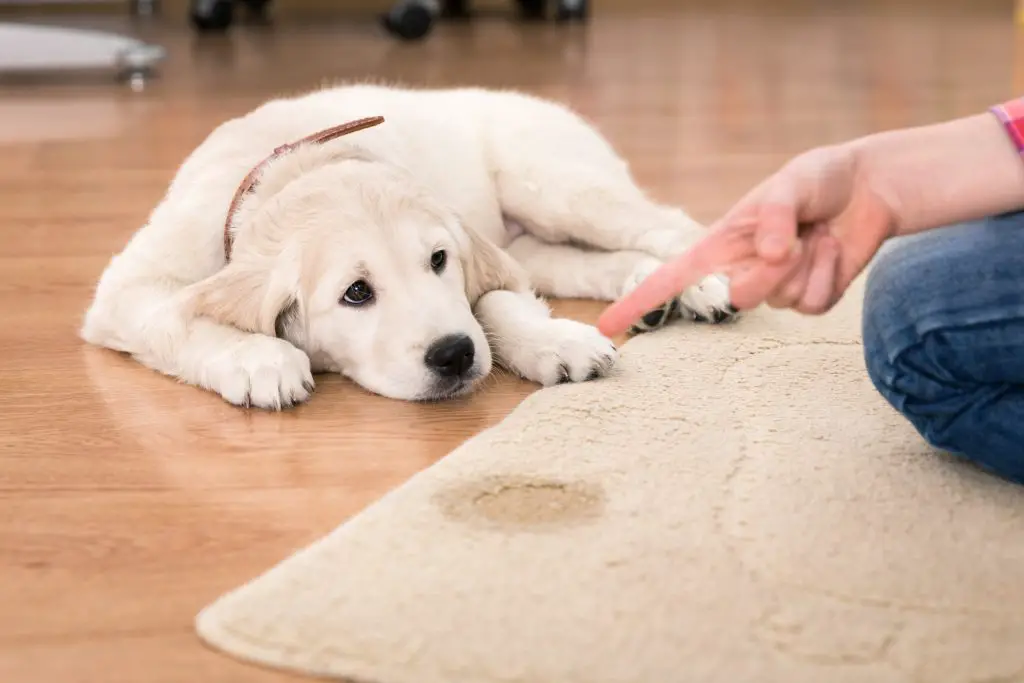
Conclusion
There is no quick or fail-proof way to housetrain your puppy. Persistence, routine and praise are all tantamount to ensuring that they understand what is required of them. While puppy potty training is time-consuming and at times pretty frustrating, the more time and effort that you put in, the faster your pup will learn.
Stay positive, remain calm and follow our guidelines to make potty training your puppy a straightforward process that the whole family can help to organize. Before you know it, those unpleasant surprises will be a thing of the past!
